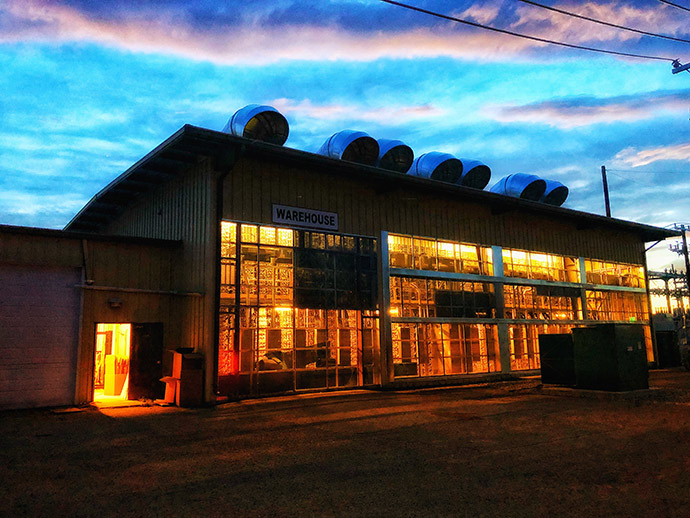Cryptocurrency miners have seen the future, and it’s in Butte, Montana.
Over the past six months, more than $350 million in new cryptocurrency mining data centers have been announced in this small southwestern Montana community, and more may be coming soon.
The tale of the tape counts CryptoWatt’s $100-million facility and Power Block Coin’s $251-million plant, on top of others that already exist in this hardscrabble town known for mining of another variety.
Matt Vincent, chief communications officer for CryptoWatt, says it’s not rocket science why his firm selected Butte-Silver Bow, the consolidated city-county jurisdiction that at its peak helped thousands of Americans amass unprecedented fortunes.
"The quicker you get online and start hashing, the more money you’re going to make," Vincent says. "Hashing" is the crypto term for running and solving the algorithm equations. Mining machines work in the terahash range, i.e. making trillions of computations per second, he explains. Thus the energy demands."We’re building state-of-the-art data centers. We’re fully invested, and we have a high degree of confidence in the long-term viability of blockchain technology. We’re building our data center to be nimble and to be around for a long time."

“We’re developing plans to grow our operation in Montana. Globally, the big focus is on cryptocurrency, but we’re just scratching the surface of this technology.”
Why CryptoWatt selected Butte — and why other cryptocurrency investors are joining them — is the story of a race to cash in on a new high-tech, high-stakes gold rush.
Butte did not receive the title of "The Richest Hill on Earth" by accident. Montana’s fifth-largest city earned the moniker as the home of gold, silver and copper mines. It’s estimated that $48 billion in rare metals has been mined from the hills of this Montana town of 33,853 people — a town which in its heyday about 100 years ago was home to between 90,000 and 100,000.
Today, a gold rush of another kind is taking shape in Mining City. Only this time, the pioneers aren’t toting shovels and pick-axes; they’re wielding ones and zeros.
Welcome to the world of cryptocurrency, where fortunes are made not with metal dug from the earth, but with bitcoin and other digital currency extracted from the internet.
If you thought this high-tech arena would be lodged squarely in the middle of Silicon Valley or the Research Triangle, think again. The miners of bitcoin, litecoin, ethereum, zcash, dash, ripple, monero and other cryptocurrencies choose to work in remote northern locations that offer plenty of cold air, cheap power and welcoming politicians.
Familiarity Breeds Bitcoin Baggers
Cryptocurrency mines require massive amounts of power and cooling because they mine online networks 24-7 to validate transactions. Successful miners are rewarded with cryptocurrency, bitcoin being the most popular of some 1,200 types. The reward lowers transaction fees by creating a complementary incentive to add to the processing power of the network. Bitcoin peaked at around $20,000 in late 2017. As of June 29, one bitcoin was valued at $5,905.
Least Expensive States for Mining Bitcoin
(Cost of Electricity Per Coin)
| 1. Louisiana | $3,224 |
| 2. Idaho | $3,289 |
| 3. Washington | $3,309 |
| 4. Tennessee | $3,443 |
| 5. Arkansas | $3,505 |
Most Expensive States for Mining Bitcoin
(Cost of Electricity Per Coin)
| 1. Hawaii | $9,483 |
| 2. Alaska | $7,059 |
| 3. Connecticut | $6,951 |
| 4. Massachusetts | $6,674 |
| 5. New Hampshire | $6,425 |
"We saw an opportunity to seize the market when bitcoin peaked at $20,000," says Vincent. "On the other side, in 2020, there will be half as many bitcoins produced daily. The sooner you get in on producing 1,800 bitcoins a day, that’s a lot better than producing 900 a day."
Hence the hurry. But CryptoWatt isn’t even the largest investor seeking to expand quickly in Butte, a town that was founded as a mining camp in 1864. That title belongs to Power Block Coin LLC, a subsidiary of Blue Castle Holdings Inc., based in Orem, Utah. If Power Block Coin has its way, it will develop a $251-million cryptocurrency mining data center in Butte.
Deconstructing the process that led these firms to Montana isn’t easy, but it follows a trend that’s seen a plethora of digital mines locate in Washington, Wyoming and other parts of the Pacific Northwest and Mountain West.
In the case of CryptoWatt, familiarity paved a smooth path to Montana.
"Our CEO Dan Burrell had quite a bit of familiarity through his other business relationships," Vincent says. "In 2015, he was looking to locate a private medical school in the Bozeman area. He eventually built it in Boise, Idaho. But feasibility studies showed that Montana had ideal temperatures for cryptocurrency mining. Only a handful of days each year exceed 77 degrees Fahrenheit. Those are the ideal temperatures you want. Plus, there’s a very strong grid with NorthWestern Energy. They offer very competitive industrial power rates. Montana in general is a very good place for data centers."
Research by Crescent Electric identifies the cheapest places in America to mine bitcoin, based upon average industrial electricity prices. In Montana, it costs $3,828 in electrical power to mine one bitcoin, ranking 12th in the U.S. Comparatively, it costs $3,289 in Idaho and $3,574 in Utah. Louisiana is the cheapest state, at $3,224. The costliest? Hawaii, at a whopping $9,483 per bitcoin — or 60 percent more than bitcoin is worth.
CryptoWatt went live with its first 3-megawatt line of 2,000 computer servers on March 14 after closing on a 53-acre site in the former Mike Mansfield Advanced Technology Center south of Butte in January. "We looked at a number of sites in Montana," notes Vincent, who holds a degree in chemistry from Montana Tech and has a background in environmental engineering and geochemistry. "None afforded the same advantages as this one. This site, with its open availability for electricity in the grid and its available industrial facilities, led us here. There were tens of thousands of square feet of industrial buildings available, and the site had its own substation. We could get our machines up and running very quickly."

“If you don’t have the local political support, you might as well not show up. The project will not get done.”
Upon buildout, CryptoWatt will reach 64 megawatts and 50 full-time workers, says Vincent. "During construction, our weekly payroll is $200,000," he adds. "We expect to generate an economic impact of $22 million a year for the regional economy upon completion."
When CryptoWatt reaches 64 MW, it will use more electricity than the entire city of Butte (48 MW) does now. By building in the South Butte Targeted Economic Development District, CryptoWatt qualifies to receive $5.5 million in incentives for the development of a new power substation. "We’ve invested $60 million so far," says Vincent. "We’ll invest another $40 million to bring this project to completion."
Building Plants for the Long Haul
Even if bitcoin goes bust, as some predict it will, Vincent says CryptoWatt is building a plant with long-term staying power.
"The type of computing power we have, whether it’s for cryptocurrency mining or artificial intelligence or other [uses], we built this plant to be part of the southwestern Montana community for a long time to come," he says. "We’re developing plans to grow our operation in Montana. Globally, the big focus is on cryptocurrency, but we’re just scratching the surface of this technology. We’re going beyond cryptocurrency. We’re innovating blockchain technology. We have proprietary systems and racking designs. We’re trying to redefine the image that our industry has from this point forward. We’ve been very transparent in the way we’ve shared what we’re doing with the community."

Vincent should know; he’s the former CEO of Butte-Silver Bow City-County Government — an elected position he held for more than four years. "At a time when speed was everything, we were able to move very quickly," he says. "That was critical. At least a dozen other cryptocurrency companies were competing to get up and running in Montana. We were able to get operational before everyone else. We are the only cryptocurrency outfit that is fully up and running in the county right now."
That situation is not likely to last for long. Power Block Coin (PBC), backed by the huge coffers of nuclear power firm Blue Castle Holdings in Utah, is nipping at CryptoWatt’s heels. In February, PBC announced its intent to develop a $251-million cryptocurrency mine in Butte. The company is currently working through its final due diligence on the project that would create 51 high-skilled jobs paying $37,000 to $48,000 a year.
Aaron Tilton, CEO of Blue Castle Holdings, says that "the first critical piece in site selection is always community support, including political support for the project. We learned this during our nuclear site search in Utah. If you don’t have the local political support, you might as well not show up. The project will not get done."
Tilton is no stranger to politics. A former Utah state representative, he served on the Utah House Public Utilities and Technology Committee as vice chair. He also served as vice chair of the board for Americans for American Energy.
The Butte-Silver Bow Council of Commissioners voted 9-0 on Feb. 21 to allow PBC to build a campus of high-powered data centers in Montana Connections, a special tax district west of Butte. "The capacity we’re building could host up to 135 megawatts on site," says Tilton. "Silver Bow developed its own industrial site to attract large users. They’re very receptive to this industry. It still takes a significant amount of creativity to make these projects go."
Large-scale cryptocurrency mines require many things, says Tilton. "Political support is No. 1. No. 2 is infrastructure," he says. "Third are the costs of the inputs like energy and labor. Those are very critical aspects. When we conducted our search, we found a couple of immediate candidates based on state and local regulations. We sift those criteria. We also consider our ability to interact with the community and state on a fairly quick basis."
It helped that the Montana legislature passed a bill in 2017 to lower property tax rates on large data centers — the types of facilities run by cryptocurrency miners. On top of that, WalletHub reported July 2 that Montana ranks as the fourth Best State to Start a Business. The same report said Montana ranks eighth best in overall business costs.
Keeping All Options Open
When asked why he picked Montana, Tilton said, "It had to do with the price of electricity in Montana tied to hydroelectric facilities in the Northwest, which provide the infrastructure for power plants and other industries like mining and lumber mills. As those operations have waned, some infrastructure has become available for other uses. The climate of the area is a factor too. Heat is an issue. You have to reject the heat to keep the data centers cool."
Tilton says the final design will include 70 to 200 separate high-density data center units. Each unit will be 300 to 400 square feet in size.
PBC is at the final due diligence stage, he adds. "We’re conducting transmission studies right now," says Tilton. "Based on the results of those studies, we’ll determine our ability to deploy the facility. We may have to pay for more transmission upgrades. For that reason, we have other locations in the region under development. It really comes down to transmission. Butte has augmented our costs with a Targeted Economic Development District deal. If another site has similar costs but is quicker to market, it will go up to No. 1 on our list."

One place that won’t be making the cut, he notes, is Missoula. On June 14, the Missoula County Commission opted to delay its decision on a proposed one-year ban on new or expanded cryptocurrency activity until August. Project Spokane LLC launched a 20-MW bitcoin mine in Bonner near Missoula in 2016, creating 25 jobs. At the time, it was the first large-scale bitcoin mine to enter the state. The uncertainty over the future political climate there, however, prompted PBC to avoid that community, says Tilton.
Out of concern for the strain on the electric grid, four electric utilities in the U.S. have imposed moratoriums or other limits on cryptocurrency mining, joining five cities in New York and Washington and several cities in Canada.
Tilton emphasizes that this is not a short-term play for Blue Castle and Power Block Coin. "We’re in this for the long haul," he says. "Our investment thesis is based on the premise that cryptocurrency is just one application of high-density data centers, along with artificial intelligence, health-care data and other applications. These types of applications will be the foundation of new networks. The real future, we believe, is in joint venturing with the applications in the field of high-density computational power. They have to collaborate with industrial site developers to make this work."
John Boyd, principal of The Boyd Company Inc. Location Consultants in Princeton, N.J., says that "power costs are a dominant driver in the siting of bitcoin mining centers. Regions like central and eastern Washington with low-cost Columbia River Valley hydroelectric power are especially attractive to this new industry. Other areas with low-cost hydroelectric power like Buffalo, TVA-served cities in the Tennessee River Valley, and Montreal, as well as solar power (Phoenix, Las Vegas and Reno) and wind (Des Moines, Ames and Omaha) are also aggressively targeting the bitcoin mining industry."
Boyd adds that "cities that wish to be in the game for bitcoin mining centers also need to be investing in the right types of infrastructure, i.e., power delivery systems and the highest-speed internet systems. And just as these centers are energy-intensive, they also have unique real estate and data security demands."
Even ‘Captain Kirk’ Lends a Nod
Boyd cites the example of Solar Alliance, a company whose spokesman is film and TV legend William Shatner of "Star Trek" fame. The company is repurposing an abandoned label factory in 8,000-resident Murphysboro, Illinois, into a bitcoin mining facility completely run on solar energy. The town’s "Renewing the Murphysboro Community Through Green Energy Jobs" initiative helped the firm repurpose the 165,000-sq.-ft. facility that had sat vacant for more than a decade.
Boyd notes that bitcoin miners aren’t just targeting abandoned factories and warehouses. Vacant malls and retail centers are being redeveloped to mine cryptocurrency too.
As more players get into the game, incentive programs must adapt as well, says Ellen Harpel, founder of Smart Incentives in Arlington, Va. "I counsel our clients, who are communities structuring incentives, to consider three things," she says. "Does the project align with your economic development strategy? What are the fiscal implications? And does the project generate broader economic benefits for the community?"
“(Communities) must consider the level of risk in these mining operations. Where there is a boom, there is a bust.”
Harpel worries about whether bitcoin mines will stand the test of time. "It’s a good practice to think through these issues," she notes. "In general, an investment into a benefit that stays in the community is a good incentive practice."
States and communities should consider the risk before becoming too eager to subsidize speculative ventures, Harpel cautions. "They must consider the level of risk in these mining operations," she advises. "Where there is a boom, there is a bust. What happens if that operation leaves the community suddenly? I advise communities to take an investment partnership approach. Will this project help your community gain a foothold in an emerging tech sector? What does everyone need to do to make this work, and how do you make it last?"
For now, as more cryptocurrency mining ventures seek out new locations in the American West, there appears to be no turning back.
Blue Castle’s Tilton says, "We have other sites under development now in multiple states, but we’re not able to disclose those." How much capacity does he have under development? "About 500 megawatts," he says.
Any way you mine it, that adds up to a lot of cryptocurrency gold.

